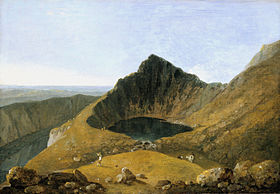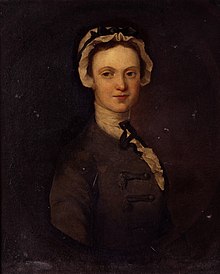| Revision as of 21:52, 18 February 2017 editJheald (talk | contribs)Autopatrolled, Extended confirmed users, Pending changes reviewers53,015 editsm →External links: clear old Art UK id & count, replaced: {{YourPaintings|richard-wilson-5055 → {{Art UK bio using AWB← Previous edit | Revision as of 11:22, 25 February 2017 edit undoBender the Bot (talk | contribs)Bots1,008,858 editsm →External links: HTTP→HTTPS for The New York Times. using AWBNext edit → | ||
| Line 76: | Line 76: | ||
| * on ] | * on ] | ||
| * entry in the Encyclopedia of Irish and World Art | * entry in the Encyclopedia of Irish and World Art | ||
| * | * | ||
| * Museo virtuale della città di Tivoli | * Museo virtuale della città di Tivoli | ||
Revision as of 11:22, 25 February 2017
| Richard Wilson | |
|---|---|
 Portrait of Richard Wilson by Anton Raphael Mengs (1752) Portrait of Richard Wilson by Anton Raphael Mengs (1752) | |
| Born | (1714-08-01)1 August 1714 Penegoes, Montgomeryshire, Britain |
| Died | 15 May 1782(1782-05-15) (aged 67) Colomendy Hall near Llanferres, Denbighshire, Wales, U.K. |


Richard Wilson RA (1 August 1714 – 15 May 1782) was an influential Welsh landscape painter, who worked in Britain and Italy. With George Lambert he is recognised as a pioneer in British art of landscape for its own sake and was described in the Welsh Academy Encyclopedia of Wales as the "most distinguished painter Wales has ever produced and the first to appreciate the aesthetic possibilities of his country". In December 1768 Wilson became one of the founder-members of the Royal Academy. A catalogue raisonné of the artist's work is published by the Paul Mellon Centre for Studies in British Art.
Life
The son of a clergyman, Richard Wilson was born on 1 August 1714, in the village of Penegoes in Montgomeryshire (now Powys). The family was an established one, and Wilson was first cousin to Charles Pratt, 1st Earl Camden. In 1729 he went to London, where he began as a portrait painter, under the apprenticeship of an obscure artist, Thomas Wright. Wilson could often be found walking around Marylebone Gardens with his acquaintance Baretti heading toward the Farthing Pie House, now known as the Green Man Public House.
From 1750 to 1757 Wilson was in Italy, and became a landscape painter on the advice of Francesco Zuccarelli. Painting in Italy and afterwards in Britain, he was the first major British painter to concentrate on landscape. He composed well, but saw and rendered only the general effects of nature, thereby creating a personal, ideal style influenced by Claude Lorrain and the Dutch landscape tradition. John Ruskin wrote that Wilson "paints in a manly way, and occasionally reaches exquisite tones of colour". He concentrated on painting idealised Italianate landscapes and landscapes based upon classical literature, but when his painting, The Destruction of the Children of Niobe (c.1759–60), won acclaim, he gained many commissions from landowners seeking classical portrayals of their estates. Among Wilson's pupils was the painter Thomas Jones. His landscapes were acknowledged as an influence by Constable, John Crome and Turner.
Wilson died in Colomendy, Denbighshire on 15 May 1782, and is buried in the grounds of St Mary's Church, Mold, Flintshire.

Works

In 1948, Mary Woodall, keeper of art at Birmingham Museum and Art Gallery, organized a pioneer exhibition of his work.
Extant works include:
- Landscapes
- Caernarfon Castle
- Cock Tavern at Cheam, at the Winnipeg Art Gallery
- Dolbadarn Castle
- Dover Castle
- Lake Avernus with a Sarcophagus, at the Worcester Art Museum, Worcester, MA
- Lydford Waterfall, Tavistock
- River at Penegoes
- The Garden of the Villa Madama, Rome
- Valley of the Mawddach with Cader Idris
- View at Tivoli
- View in Windsor Great Park
- Cilgerran Castle
- Classical Landscape, Strada Nomentana
- Conway Castle
- Dolgellau Bridge
- The Niagara Falls'
- Pistyll Rhaeadr, Aber Falls
- Solitude (or Landskip with Hermits)
- Other
- Ceyx and Alcyone (1768)
- Francis Ayscough, Dean of Bristol and tutor to George III of England with his pupils
- Miss Catherine Jones of Colomendy (1740)
References
- References
- Steven J. Gores (2000). Psychosocial Spaces: Verbal and Visual Readings of British Culture, 1750–1820. Wayne State University Press. p. 37. ISBN 978-0-8143-2663-3. Retrieved 14 June 2013.
- Davies, Jenkins et al (2008) p. 966.
- Davies, Jenkins et al (2008) p.965
- Richard Wilson - Online!, paul-mellon-centre.ac.uk 10 December 2014. Retrieved 28 May 2016. Archived here.
- Welsh Biography online
- "British History Online". Retrieved 11 February 2015.
- "The Green Man". Retrieved 11 February 2015.
- John Ruskin. Modern Painters, Volume I: Part II. 189.
{{cite book}}: CS1 maint: location (link) - Kenneth Garlick, ‘Woodall, Mary (1901–1988)’, Oxford Dictionary of National Biography, Oxford University Press, Sept 2004
Further reading
- Lee, Sidney, ed. (1900). "Wilson, Richard" . Dictionary of National Biography. Vol. 62. London: Smith, Elder & Co. pp. 120–23.
- Cole, Timothy. Old English masters (New York : The Century Co., 1902) pp. 67–76.
- Fletcher, Beaumont. Richard Wilson. R.A. The Makers of British Art (Walter Scott, London, 1908).
- Encyclopædia Britannica 1911. Richard Wilson.
- Edwards, R. 'Richard Wilson and his pupil', in Country Life (1945 November)
- Ford, B. The Drawings of Richard Wilson (1951)
- Constable, W. G. Richard Wilson (1953)
- Spencer-Longhurst, Paul. Richard Wilson: Online Catalogue Raisonné (London: Paul Mellon Centre, 2014).
- Sutton, Denys & Clement, Ann. An Italian sketchbook: drawings made by the artist in Rome and its environs (Routledge & Kegan Paul, 1968).
- Solkin, David H., Richard Wilson: The Landscape of Reaction (Tate Gallery, London, 1982).
- Davies, John, Nigel Jenkins, Menna Baines and Peredur Lynch (Eds.). The Welsh Academy Encyclopaedia of Wales (University of Wales Press, 2008). ISBN 978-0-7083-1953-6
External links
- 285 artworks by or after Richard Wilson at the Art UK site
- Works by Richard Wilson on Google Art Project (50 works)
- Works by Richard Wilson on ArtCyclopedia
- Richard Wilson entry in the Encyclopedia of Irish and World Art
- The Mystery of the British Landscape Master, The New York Times, 4 June 2010
- Museo virtuale della città di Tivoli